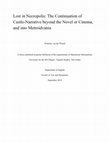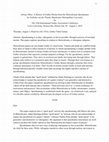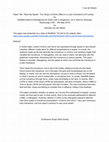Papers by Persephone van der Waard
A school paper I wrote for Professor Eric Acton's Linguistics of Gender/WTRG 326 while at Eastern... more A school paper I wrote for Professor Eric Acton's Linguistics of Gender/WTRG 326 while at Eastern Michigan University. Said paper explores the cis-het communication goals of gamers who swear in relation to sexuality and gender. It explores how—due to a popular online options for aggressive behavior online being verbal/anonymous due to "[e-community solidarity being] facilitated by [an] anonymity [that also] guarantees online equality"—such aggressive behavior can be radically motivated by sexual dynamics once said anonymity is removed and equality disturbed.
This twice-rejected paper has been submitted, here as a final document that I do not plan on edit... more This twice-rejected paper has been submitted, here as a final document that I do not plan on editing further, but instead want to preserve as it currently exists. It examines Gothic affect in videogames, specifically the first-person shooter (FPS) Blood (1997), developed by Monolith Productions. It explores the FPS's "heavy emphasis on combat, typically involving firearms" as told through a first-person viewpoint. This paper explores how Blood affects players through a Gothic FPS framework; furthermore, its response from the player is not driven by fear for fear's sake. It is nostalgic and fun in ways that go beyond fear-and-nothing-else.
Gothic viewers are affected by a replicated past. To communicate it, and the Gothic territory where it resides, there will always be replication, this paper argues.
A critical review I wrote in 2017 for my 20th century Gothic module as part of Manchester Metropo... more A critical review I wrote in 2017 for my 20th century Gothic module as part of Manchester Metropolitan University's MA Program, "English Studies: the Gothic" (which I received my MA for, December 2018).
Eastern Michigan University, 2014
This 2014 undergrad essay explores themes of birth trauma in Mary Shelley's Frankenstein (1818) n... more This 2014 undergrad essay explores themes of birth trauma in Mary Shelley's Frankenstein (1818) not from Freud's ideas but Otto Rank's The Trauma of Birth (1929).
Undergrad essay at Eastern Michigan University, 2015
This essay was written in 2015 for Dr. Sandy Norton's Women's Studies course at Eastern Michigan ... more This essay was written in 2015 for Dr. Sandy Norton's Women's Studies course at Eastern Michigan University. It explores the history of Charlotte Brontë's relationship with her sister, Emily, including a) how she helped her publish Wuthering Heights, but also b) Charlotte's central (and liberal) role in establishing Emily's reputation as poet posthumously.

Manchester Metropolitan University, 2018
This dissertation concerns terror in Gothic stories, wherein space is predominant, and bigger tha... more This dissertation concerns terror in Gothic stories, wherein space is predominant, and bigger than the monsters inside. These spaces are examined according to Mikhail Bakhtin's chronotope of castle-narrative, which outlines the Gothic as a storytelling mode according to conventions of the novel. This dissertation moves beyond the novel, and examines the castle-narrative as told through motion in response to Gothic affect-this can be found all across media, and manifests according to six qualities of Gothic space by which time is always a factor. Chapter 1 outlines these qualities in further detail, and applies them to older Gothic media, from Radcliffean novels to 20th century cinema. Chapter 2 examines ergodic forms of Gothic castle-narrative, told by speedrunners inside videogames called Metroidvania, the two having evolved hand-in-hand; it also examines perennial Gothic devices that mutate within conventions of media, but also in response to narratives of motion through Gothic space rife with doubles: gender, the labyrinth, and the Other. Chapter 3 close-reads two Metroidvania, the ur-text, Metroid (1986), and the recent, critically-acclaimed Hollow Knight (2016).

This paper compares and contrasts notions of rarefied greed in Tolkien's novel, The Hobbit, compa... more This paper compares and contrasts notions of rarefied greed in Tolkien's novel, The Hobbit, compared alongside Shakespeare's play, The Merchant of Venice, when taking into consideration the idea of wealth as defined by Max Weber in his own work, "The Protestant Ethic and the Spirit of Capitalism." The idea of greed in Tolkien's world, is older, fro ma more traditional moral-driven framework featuring Tolkien's own version of racial tropes; on the other hand, Shakespeare's play is penned in an older period, but is more modern or progressive in its ideas of greed, deviating away from rarefied symbols, like the Medieval dragon, in favor of illustrating the exchanges of wealth between the burgeoning merchant class in the Renaissance period as seen as tolerated through motifs of religious friction and bigotry disguised as Christian generosity and limited to interactions between human characters, even if those characters are described as inhuman or animal.

This paper serves to compare and contrast science fiction and horror short story writer H.P. Love... more This paper serves to compare and contrast science fiction and horror short story writer H.P. Lovecraft alongside Argentinian short story writer Jorges Luis Borges, by examining various scholarships that have done the same, especially Barton St. Armand's illuminating essay "Synchronistic Worlds." It is also interested in Lovecraft's curious longevity long after his death and why we, as readers, continue to gravitate towards his writing in popular culture despite his notorious political incorrectness and blatant xenophobia. This paper examines Lovecraft as a iconoclast, treating his writings as effective language experiments, as well as going further back in time, to examine the Gothic mode of storytelling through older ideas proposed by Rudolf Otto and Edmund Burke, which serve as the heart of the Gothic tale. Despite Lovecraft's abstract or "bad" style, I am convinced through my own examination of Otto and Burke that he understood very well what they would've called the Sublime and the "mysterium tremendum," and what these concepts were getting at. I feel that this makes his own short stories work as well as they do and why they continue to be as popular as they are, today, in spite of his flaws as a person and a wordsmith.
Drafts by Persephone van der Waard

MMU Grad School module essay, 2017
When I initially wrote this, I saw a Gothic Heroine as simply just that-a Gothic Heroine. But the... more When I initially wrote this, I saw a Gothic Heroine as simply just that-a Gothic Heroine. But the harder I looked, the more I felt as though there were differences between those of now (the 1970s-90s) and back then (the 1790s); but, at the end, I was back where I started, a Gothic Heroine being a Gothic Heroine. I felt like I was fumbling around in the dark, gradually arriving at that conclusion that the 1970s Gothic Heroine was an Amazon, but one who didn't want to be seen as monstrous. Eventually she evolved into what I described as a protector, reclaiming traditionally-male creative forces and indemnifying herself as an Amazon by associating these forces through gender performance with the female body instead of the male. Then, I stumbled on André Viola, whose essay confirmed everything that I had written, describing the phenomena of male creative mastery that began as a mythic progress reaching back, thousands of years: the origins of schismogenesis, and the Patriarchal male creator. At this moment, I felt as though I had been standing in Athena's shadow, describing something so long-standing and colossal that I didn't know it was there, nor that the shadow belonged to it.
Conference Presentations by Persephone van der Waard
This symposium talk (supervised by Dr. Bernard Miller at EMU in 2017) concerns the nature of lyin... more This symposium talk (supervised by Dr. Bernard Miller at EMU in 2017) concerns the nature of lying utilized by academic critics and famous authors across space and time. It considers Fredric Jameson in relation to the genres he critiques, but also other authors and thinkers who came before him who tackled similar subjects: A commonality of lying shared with the likes of Wolfgang Iser, Jonathan Swift, Plato, Jane Austen, Edward Said, Thomas More and Ursula Le Guin." The point in doing so is that "the truth," or universal interpretation, is a dubious concept and should be challenged by questioning it in ways that are useful to us.

The 15th International Gothic Association Conference, 2019
Speedrunning is to play videogames as fast as possible, through a process of recorded motion. Thi... more Speedrunning is to play videogames as fast as possible, through a process of recorded motion. This paper explores speedruns in relation to Metroidvania, a videogame subgenre.
Metroidvania games are not simply Gothic in visual terms. Trauma and death are codified inside their space to build or affect narratives of motion, to which speedrunning is simply another form. In Metroidvania, motion is always Gothic (of terror and horror): it cannot exist in isolation from Gothic structures that represent constant temporal exchange. For the speedrunner, motion equates to gained time. They strive to avoid not just death, but losing time through failure. They fashion rules relative to a tyrannical space they hope to master. Through their own history as a group, speedrunners historicize Metroidvania’s Gothic themes through a structure that exerts continual dominance over them. Their records of motion remain Gothic in form and function, through kaleidoscopically variable routes that encourage the highly-repetitive motion of speedrunning.
Charles Pratt amends that “spoil-sports” (defined by Johan Huizinga as “persons who do not acknowledge or respect the jurisdiction of a game’s ruleset”) are generative and destructive. Unlike Pratt, this paper categorizes speedrunners as striving to play Metroidvania as intended, “taken off the shelf and put into a machine.” These activities serve as “a social confluence of motivations and practices” that accumulate within Metroidvania as Gothic chronotopes: corpses, statues, and effigies. Speedrunning is symbolized inside the game—as a historical event, and part of a flexible ruleset extolled by Metroidvania developers in favor of Gothic motion.

Sheffield Gothic's Reimagining the Gothic with a Vengeance, Vol 5: Returns, Revenge, Reckonings, 2019
In Gothic tales, notions of terror and horror are expressed through speed or lack thereof. Likewi... more In Gothic tales, notions of terror and horror are expressed through speed or lack thereof. Likewise, different media allow for different presentations on speed. In a book, the audience reads words that describe the monstrous; in cinema, one watches images that visualize the monstrous. In videogames, one can read or watch, but also play with the graphical components, interacting with the monstrous at various speeds. This paper wishes to consider videogames, and the speed at which one confronts the monstrous in a ludic framework.
Terror hides the monstrous; one is lost in the castle, waiting to bump into the beast. Horror shows the monstrous, out in the open; the gore and the grotesque are on full display. In media, one can see the discrepancy not just in what is shown, but the speed in which it arrives at, and is viewed after, in monstrous form. In novels, Radcliffe teases out the monstrous through terror, while Lewis annihilates in full view. In cinema, Alien (1979) or Dawn of the Dead (1978) are slow-paced, with slow monsters; Aliens (1986) or Train to Busan (2016) are fast-paced, with fast monsters. The slow monstrous becomes feral and fast, versus something to consider from a distance, hiding in the shadows.
This paper considers variation on speed, as it occurs from palimpsest to sequel—across media, but from text to text. In other words, Alien is the cinematic palimpsest for Metroid (1986), a videogame. However, Metroid 2 (1991) is the videogame sequel to Metroid. How does speed of monstrous presentation—of terror and horror—vary upon entering a ludic framework, and how does it continue to vary once inside?
International Gothic Association, 2018
In response to Adam Curtis Hypernormalization (2016), this symposium discusses hypernormality in ... more In response to Adam Curtis Hypernormalization (2016), this symposium discusses hypernormality in the Strugatsky Brothers’ Roadside Picnic (1971) and Jeff Vandermeer’s Annihilation (2014). It aims to examine how Gothic can be detached from the dated past, its subsequent effect on a particular space coming from elsewhere—from indeterminate or unorthodox origins, like the future or the cold vacuum of space.










Uploads
Papers by Persephone van der Waard
Gothic viewers are affected by a replicated past. To communicate it, and the Gothic territory where it resides, there will always be replication, this paper argues.
Drafts by Persephone van der Waard
Conference Presentations by Persephone van der Waard
Metroidvania games are not simply Gothic in visual terms. Trauma and death are codified inside their space to build or affect narratives of motion, to which speedrunning is simply another form. In Metroidvania, motion is always Gothic (of terror and horror): it cannot exist in isolation from Gothic structures that represent constant temporal exchange. For the speedrunner, motion equates to gained time. They strive to avoid not just death, but losing time through failure. They fashion rules relative to a tyrannical space they hope to master. Through their own history as a group, speedrunners historicize Metroidvania’s Gothic themes through a structure that exerts continual dominance over them. Their records of motion remain Gothic in form and function, through kaleidoscopically variable routes that encourage the highly-repetitive motion of speedrunning.
Charles Pratt amends that “spoil-sports” (defined by Johan Huizinga as “persons who do not acknowledge or respect the jurisdiction of a game’s ruleset”) are generative and destructive. Unlike Pratt, this paper categorizes speedrunners as striving to play Metroidvania as intended, “taken off the shelf and put into a machine.” These activities serve as “a social confluence of motivations and practices” that accumulate within Metroidvania as Gothic chronotopes: corpses, statues, and effigies. Speedrunning is symbolized inside the game—as a historical event, and part of a flexible ruleset extolled by Metroidvania developers in favor of Gothic motion.
Terror hides the monstrous; one is lost in the castle, waiting to bump into the beast. Horror shows the monstrous, out in the open; the gore and the grotesque are on full display. In media, one can see the discrepancy not just in what is shown, but the speed in which it arrives at, and is viewed after, in monstrous form. In novels, Radcliffe teases out the monstrous through terror, while Lewis annihilates in full view. In cinema, Alien (1979) or Dawn of the Dead (1978) are slow-paced, with slow monsters; Aliens (1986) or Train to Busan (2016) are fast-paced, with fast monsters. The slow monstrous becomes feral and fast, versus something to consider from a distance, hiding in the shadows.
This paper considers variation on speed, as it occurs from palimpsest to sequel—across media, but from text to text. In other words, Alien is the cinematic palimpsest for Metroid (1986), a videogame. However, Metroid 2 (1991) is the videogame sequel to Metroid. How does speed of monstrous presentation—of terror and horror—vary upon entering a ludic framework, and how does it continue to vary once inside?
Gothic viewers are affected by a replicated past. To communicate it, and the Gothic territory where it resides, there will always be replication, this paper argues.
Metroidvania games are not simply Gothic in visual terms. Trauma and death are codified inside their space to build or affect narratives of motion, to which speedrunning is simply another form. In Metroidvania, motion is always Gothic (of terror and horror): it cannot exist in isolation from Gothic structures that represent constant temporal exchange. For the speedrunner, motion equates to gained time. They strive to avoid not just death, but losing time through failure. They fashion rules relative to a tyrannical space they hope to master. Through their own history as a group, speedrunners historicize Metroidvania’s Gothic themes through a structure that exerts continual dominance over them. Their records of motion remain Gothic in form and function, through kaleidoscopically variable routes that encourage the highly-repetitive motion of speedrunning.
Charles Pratt amends that “spoil-sports” (defined by Johan Huizinga as “persons who do not acknowledge or respect the jurisdiction of a game’s ruleset”) are generative and destructive. Unlike Pratt, this paper categorizes speedrunners as striving to play Metroidvania as intended, “taken off the shelf and put into a machine.” These activities serve as “a social confluence of motivations and practices” that accumulate within Metroidvania as Gothic chronotopes: corpses, statues, and effigies. Speedrunning is symbolized inside the game—as a historical event, and part of a flexible ruleset extolled by Metroidvania developers in favor of Gothic motion.
Terror hides the monstrous; one is lost in the castle, waiting to bump into the beast. Horror shows the monstrous, out in the open; the gore and the grotesque are on full display. In media, one can see the discrepancy not just in what is shown, but the speed in which it arrives at, and is viewed after, in monstrous form. In novels, Radcliffe teases out the monstrous through terror, while Lewis annihilates in full view. In cinema, Alien (1979) or Dawn of the Dead (1978) are slow-paced, with slow monsters; Aliens (1986) or Train to Busan (2016) are fast-paced, with fast monsters. The slow monstrous becomes feral and fast, versus something to consider from a distance, hiding in the shadows.
This paper considers variation on speed, as it occurs from palimpsest to sequel—across media, but from text to text. In other words, Alien is the cinematic palimpsest for Metroid (1986), a videogame. However, Metroid 2 (1991) is the videogame sequel to Metroid. How does speed of monstrous presentation—of terror and horror—vary upon entering a ludic framework, and how does it continue to vary once inside?